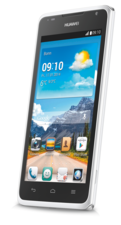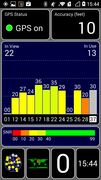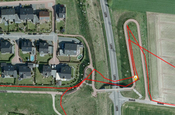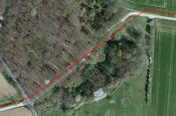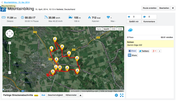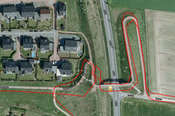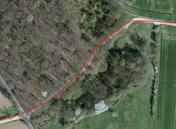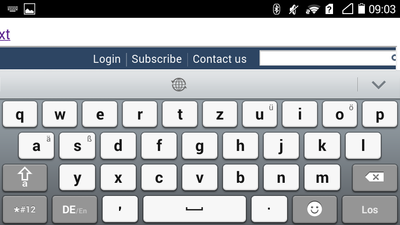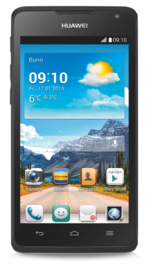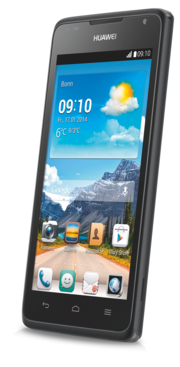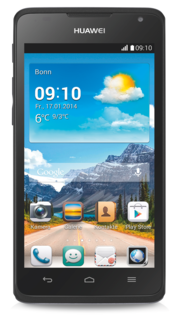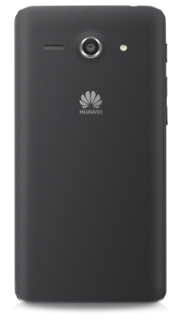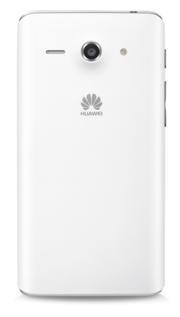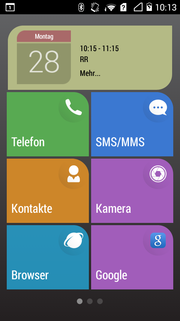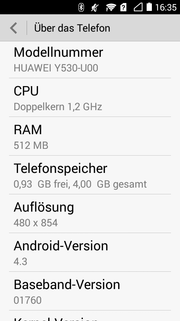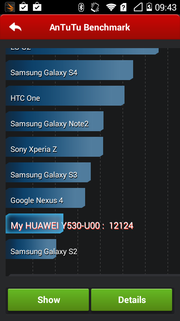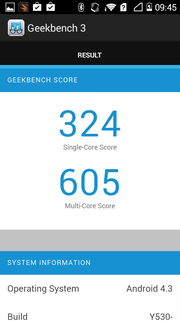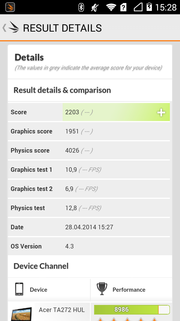Review Huawei Ascend Y530 Smartphone

For the original German review, see here.
Some relevant online shops list Huawei's Ascend Y530 for only 120 Euros (~$166). An up-to-date Android smartphone will barely be found for less - especially when it features Android 4.3 and a 4.5-inch screen. The Chinese manufacturer is thus launching a true value-for-money sensation. It is important that the necessary austerity measures do not have a major impact on daily usage. However, it is also obvious that cutbacks have to primarily be made in storage capacity and the key component, the SoC, when the low price point is to be met in an economically reasonable manner.
Huawei relies on a relatively new SoC from Qualcomm. The decision for this very reputable manufacturer already puts Huawei in a good light seeing that Qualcomm provides the currently fastest mobile processors. Of course, a much slower model operates in the Y530. The Snapdragon 200 MSM8210 is a dual-core model with a clock rate of 1.2 GHz. An Adreno 302 is responsible for graphics calculations, which is a new entry-level model from Qualcomm. This meets the 4.5-inch smartphone's claim, just like the 512 MB working memory, the small yet expandable 4 GB of internal storage, and the screen's resolution of 854x480 pixels, that the Y530 has in common with the bigger and more expensive Ascend G610 model. Huawei also transfers the camera configuration of a 0.3 MP unit on the front and a 5 MP lens on the back in the entry-level model.
As to contenders in this price range, there are not many up-to-date models available. The equally sized dual-SIM Acer Liquid E1 Duo would come into question. Apart from that, the ZTE Blade III and the LG L5 II are alternatives, although they both have slightly smaller screens.
Case
Highlights in design are rare in this price range. However, the casing of Huawei's Y530 is not completely trite. The slightly rounded corners and the roughened battery cover pulled halfway over the edge at least give the entry-level smartphone a bit of individuality. A white model is also available as an alternative to the black device.
The Y530 is not a lightweight with 145 grams but is nevertheless pleasant to hold. This is also due to its thickness of just 9.3 millimeters and the compact dimensions that comply with the slim line.
We also liked the casing's build quality and rigidness, as it could barely be warped. However, creaking and snapping noises were produced quite early in the corresponding tests.
Connectivity
A recommended retail price of 149 Euros (~$206), that must have an impact on the connectivity; and it does. However, Huawei, fortunately, has not blundered massively here. Overall, the configuration makes a balanced impression and fits to the entry-level category. The key component is a dual-core SoC from Qualcomm. The Snapdragon 200 MSM8210 was introduced not long ago, and we are testing it for the first time. Huawei's Ascend Y530 clocks with 1.2 GHz. An Adreno 302, which is a downright low-end model, provides graphics power. A 512 MB working memory and 4 GB of internal storage support the SoC. Neither are much in this price range, but the latter can be expanded by up to 32 GB via a micro-SD card. We did not discover any highlights - except for maybe that the power button and volume rocker are located on the casing's left edge.
Software
Huawei uses a fairly up-to-date version of Google's operating system in its new entry-level model with Android 4.3 Jelly Bean. However, KitKat 4.4 would certainly have been a good choice since it is considerably more sparing on resources - especially in view of the limited performance in this price range. Huawei is apparently not yet planning an update though. Huawei's Emotion UI skin also covers Android in the Y530. A special feature in the 4.5-inch smartphone is, however, the option to switch between two operating modes. Large tiles that slightly resemble Window's Phone 8 are displayed in the Easy UI mode, which is the "simple" home-screen style. In fact, we believe that this view is very well suitable for smartphone newbies.
Communication & GPS
LTE, dual-band Wi-Fi, NFC? Certainly not in this price range. However, Huawei's Ascend Y530 definitely has a solid communication configuration. Reception should be possible almost anywhere in the world with quad-band GSM (850/900/1800/1900 MHz). Dual-band UMTS (900/2100 MHz) alongside HSPA+ provides speedy data transmission rates, and Bluetooth 4.0 ensures energy-efficient short-range connections, for example, to other smartphones or peripherals such as headsets or fitness wristbands.
An A-GPS receiver is also installed. It only needs a few seconds to find a satellite and immediately achieves a high accuracy even indoors. Minor drawbacks were displayed in real-life use on an approximately 11-kilometer MTB route compared with a Garmin Edge 500 navigation system. Huawei's Ascend Y530 shortens the total route by over 300 meters. This is because the GPS receiver tends to "ignore" curves, i.e. it calculates the beeline rather than the real route. In a nutshell, the navigation performance is acceptable though.
Telephony and Speech Quality
The phone app is very clearly arranged, and even newcomers will soon manage easily. Phone numbers are entered quickly and without typos, owing to the large number buttons.
The speech and audio quality also satisfied us. The called person understood us perfectly, and the voice also sounded quite natural. Communication was only difficult in loud surroundings due to the lack of noise cancellation. The speaker is unsuitable for use as a hands-free replacement. The volume level setting in telephone mode is simply too low.
Cameras & Multimedia
A measurement of 0.3 megapixels on the front is not exactly a sensation even in the entry-level category. The popular selfies are correspondingly lifeless, and the camera is just still suitable for video chats. A 5 MP lens is installed on the back. Its resolution is high enough to perhaps use Huawei's Ascend Y530 as a replacement for a conventional digital camera. But pixels are not everything. The unit in the Y530 struggles with weak light output, which leads to minor noise issues in bright daylight. However, very bright picture areas appear overexposed. Not least, it lacks focus.
Accessories
In addition to the battery and power supply, Huawei includes a stereo headset. A very fair gesture considering the low price. More accessories will soon be available in Huawei's online shop.
Warranty
To put it briefly: 2 years on the smartphone, and six months on the battery.
Input Devices and Controls
As to the keyboard, the same applies here as ascertained in the recently reviewed Huawei Ascend G610 - excepting for the slightly smaller size. Thus, we will quote it at this point: "Huawei's Emotion UI includes its own keyboard layout that involves both advantages and disadvantages compared with the stock Android keyboard. For example, the uppermost key row always has to be pressed for a long time to enter numbers, the space bar is assigned with ".com" in the browser, and a smiley button is available. It is also possible to switch between the German and English keyboard layout. Unfortunately, the system does not permanently save the selected setting, and the setting first has to be saved elsewhere. The click noise and vibration clearly enhance the keyboard's feedback."
The touchscreen also does a satisfactory job and is highly accurate up into the edges. The fingers don't always glide smoothly over the surface and sensitive users will notice a short delay - for example, when scrolling. Nevertheless, smooth operation is mostly possible. Only very energetic inputs and very large websites cause the smartphone to stutter.
Display
In view of the price below 150 Euros (~$208), only the screen's size deserves a special mention. 4.5-inches is anything but usual; there are still many devices that feature a 3 before the point in the entry-level sector. The resolution of 854x480 pixels is naturally not very high, but a good choice for a budget smartphone - particularly considering the screen's good rates. The maximum brightness is 388 cd/m², and the illumination is a very good 91%. Although the screens in LG's L5 II and Acer's Liquid E1 Duo are even brighter, the Y530's results are certainly satisfying. Not quite as pleasing is the high black level of 0.74 cd/m² that leads to an only middling contrast of 507:1. The comparison devices all score considerably better here.
| |||||||||||||||||||||||||
Brightness Distribution: 91 %
Center on Battery: 375 cd/m²
Contrast: 507:1 (Black: 0.74 cd/m²)
ΔE ColorChecker Calman: 8.8 | ∀{0.5-29.43 Ø4.78}
ΔE Greyscale Calman: 8.69 | ∀{0.09-98 Ø5}
Gamma: 2.03
CCT: 8507 K
Subjectively, the weak contrast leads to a rather pale color reproduction. The UI looks hazy particularly when the "Easy Mode" is used. Apart from that, the screen does a good job. However, we missed the last bit of sharpness.
We used the X-Rite i1Pro 2 colorimeter to assess the screen objectively. A visible bluish cast in the grayscale reproduction became evident using the CalMAN software. The color temperature is clearly too high here. Untrained eyes will not notice the shifts in the primary colors. Quite the opposite is true in mixed colors: an average DeltaE of 8.8 is very high. The screen also shows weaknesses in color saturation.
Direct sunlight should be avoided when using the Huawei Y530 outdoors. The extremely reflective surface alongside the middling brightness cannot defy bright sunlight. However, the viewing angles are beyond reproach although Huawei generally only specifies a TFT screen. The stable viewing angles with the light-reddish glow on a black surface and the flat angles, however, point to an IPS or similar technology. We have seen considerably worse screens in this price range.
Performance
Qualcomm's Snapdragon 200 MSM8210 dual-core processor does the computing work in Huawei's Ascend Y530. This still relatively new SoC fuses two Cortex A7 cores that clock with 1.2 GHz each in the Y530. We basically find opting for a Qualcomm SoC a good idea because the Snapdragons from the 800 line regularly achieve new top scores in the smartphone premium range. Nevertheless, two A7 cores with rather low clock frequencies do not promise miracles. That is also true for the installed Adreno 302 GPU, which, however, fits well in the entry-level sector.
The benchmarks show that the GPU is more present than the CPU in the benchmarks. Huawei's Ascend Y530 scores worse than either LG's L5 II or Acer's Liquid E1 Duo in almost all benchmarks. Motorola's Moto G and Google's Nexus 5 are in their own league in the system tests. However, it looks different as soon as graphics power outweighs. Although the Y530 is still remote from high performance, it can at least keep some of its budget contenders at bay. The graphics power is enough for many current games. Really demanding titles only run fairly smoothly in low details though. Unfortunately, we could not run all benchmarks due to the limited working memory.
Huawei's Ascend Y530 did quite a good job in the browser tests, and that is noticed in everyday use. Browsing is well possible with the low-budget phone. Low-budget was likely also the motto for choosing the internal storage though. It does not sport any of the swiftest chips.
| Geekbench 3 | |
| 32 Bit Single-Core Score (sort by value) | |
| Huawei Ascend Y530 | |
| LG L90 | |
| Motorola Moto G 1. Gen XT1032 | |
| Google Nexus 5 | |
| 32 Bit Multi-Core Score (sort by value) | |
| Huawei Ascend Y530 | |
| LG L90 | |
| Motorola Moto G 1. Gen XT1032 | |
| Google Nexus 5 | |
| AnTuTu v4 - Total Score (sort by value) | |
| Huawei Ascend Y530 | |
| LG L90 | |
| Motorola Moto G 1. Gen XT1032 | |
| Google Nexus 5 | |
| PassMark PerformanceTest Mobile V1 - System (sort by value) | |
| Huawei Ascend Y530 | |
| Acer Liquid E1 Duo | |
| LG L90 | |
| Motorola Moto G 1. Gen XT1032 | |
| ZTE Blade III | |
| Google Nexus 5 | |
| GFXBench (DX / GLBenchmark) 2.7 | |
| T-Rex Onscreen (sort by value) | |
| Huawei Ascend Y530 | |
| LG L90 | |
| Motorola Moto G 1. Gen XT1032 | |
| ZTE Blade III | |
| Google Nexus 5 | |
| 1920x1080 T-Rex Offscreen (sort by value) | |
| Huawei Ascend Y530 | |
| LG L90 | |
| Motorola Moto G 1. Gen XT1032 | |
| Google Nexus 5 | |
| 3DMark - 1920x1080 Ice Storm Extreme Score (sort by value) | |
| Huawei Ascend Y530 | |
| LG L90 | |
| Motorola Moto G 1. Gen XT1032 | |
| Mozilla Kraken 1.1 - Total (sort by value) | |
| Huawei Ascend Y530 | |
| LG L90 | |
| Google Nexus 5 | |
| Octane V2 - Total Score (sort by value) | |
| LG L90 | |
| Google Nexus 5 | |
| Google Nexus 5 | |
| Sunspider - 1.0 Total Score (sort by value) | |
| Huawei Ascend Y530 | |
| Acer Liquid E1 Duo | |
| Acer Liquid E1 Duo | |
| LG L90 | |
| Motorola Moto G 1. Gen XT1032 | |
| Google Nexus 5 | |
| Google Nexus 5 | |
| Peacekeeper - --- (sort by value) | |
| Huawei Ascend Y530 | |
| Acer Liquid E1 Duo | |
| LG L90 | |
| Motorola Moto G 1. Gen XT1032 | |
| ZTE Blade III | |
| Google Nexus 5 | |
* ... smaller is better
Emissions
Temperature
Some smartphones reach temperatures of 50 °C and more at single points on the casing during full load. That feels unpleasant. Huawei's Ascend Y530 is remote from these rates. A maximum of 36.7 °C will not burn even the hands of a child. The surface also remains considerably cooler during routine use with a maximum of 30.1 °C. The power supply gets lukewarm at best, so there is no reason for complaint.
(+) The maximum temperature on the upper side is 36.7 °C / 98 F, compared to the average of 35.2 °C / 95 F, ranging from 21.9 to 247 °C for the class Smartphone.
(+) The bottom heats up to a maximum of 34.5 °C / 94 F, compared to the average of 34 °C / 93 F
(+) In idle usage, the average temperature for the upper side is 28.2 °C / 83 F, compared to the device average of 32.9 °C / 91 F.
Speakers
The sole speaker in Huawei's Ascend Y530 is on the upper-left back. Since we have just heavily criticized the speaker in the Ascend G610, our expectations for the entry-level model were very low. In fact, the little speaker even managed to positively surprise us a bit. The sound is clearer, and the maximum volume is higher. There is even a hint of bass. However, the best thing is that the trebles are not as overemphasized as in the G610.
Energy Management
Power Consumption
We often ascertain a clearly increased standby power consumption in entry-level smartphones with a low-budget SoC. However, Huawei's decision to install a brand-name SoC in the Ascend Y530 is likely very obvious here. We measured an off and standby power consumption of just 0.1 watts - exemplary. The 4.5-inch device is also quite frugal in total. The idle power consumption fluctuates between 0.5 and 1.3 watts, and the multimeter never recorded more than two watts even during load. That gives hope for long battery runtimes.
| Off / Standby | |
| Idle | |
| Load |
|
Key:
min: | |
Battery Runtime
The lithium-ion battery supplies 6.5 Wh, and its capacity is exactly on average with the comparison group. The battery runtime measurements during full system load and maximum brightness already make it obvious that Huawei's entry-level phone lasts for a relatively long time. It achieves almost three-and-a-half hours, which is considerably more than LG's L5 II and co. Motorola's Moto G, however, lasts one-and-a-half hours longer.
This impression continues in browsing via a Wi-Fi connection and a brightness of 150 cd/m². The Y530 defeats many budget phones in this test with a runtime of over eight hours.
Verdict
A bigger screen than in Apple's iPhone 5S for a fifth of the price - Huawei's Ascend Y530 lures customers with this. Although many other manufacturers from the low-budget sector use this strategy, the fewest have managed to implement it as well as Huawei has. Many budget smartphones "stand out" with an inferior build, poor screens, and anything but a smooth operation. Not the Ascend Y530.
The choice of materials and build quality would also look good in a mid-range smartphone. Huawei's Ascend Y530 is surely not a design highlight, but it is not exactly boring either. It would be nice if the battery cover did not produce annoying creaking noises so easily though.
The configuration is typical for the entry-level sector, but nothing really important has been left out. The SoC comes from Qualcomm - a good choice - and though it is not particularly speedy it copes well with daily requirements. However, 512 MB of working memory is sometimes the bottleneck, especially in demanding applications and games. That was certainly the reason why some of our benchmarks refused to run.
The screen deserves the label "Good." Even if it cannot be described with any positive superlatives, negative ones cannot be used either. In a nutshell, more cannot be expected in this price range - considerably less is the rule.
The cameras are usually austerity victims in the budget sector. The Y530 is not a big exception here. Although the front-facing camera is virtually unusable, the primary camera shoots pictures in a relatively high resolution and acceptable quality. It should suffice for social networking.
Since the Ascend Y530 does not exhibit any major drawbacks otherwise - battery runtime, temperature development and speech quality are absolutely acceptable - our verdict is: Huawei's Ascend Y530 is one of the few overall well-conceived entry-level smartphones for a fair price.




